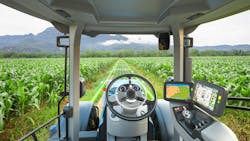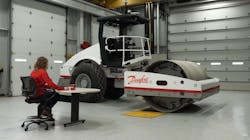Development of autonomous systems and vehicles in the off-highway equipment industry – a key customer segment for fluid power – is on the rise. Understanding the different levels of autonomy possible and the technologies involved ensures the design of an autonomous solution which best meets the needs of a given application.
As hydraulics and pneumatics are integral to the operation of construction, agricultural and other off-highway equipment, they often play an important part in and are directly impacted by the automation systems being created for this market (see sidebar below).
According to Peter Bleday, Head of Autonomy at Danfoss Power Solutions, there are three core problems autonomy is looking to solve in the off-highway equipment industry:
- addressing shortages in labor and skilled labor by improving machine and operator productivity,
- reducing rework and increasing first-time quality by performing precision tasks faster and more reliably, and
- reducing the risk of accidents and associated costs by improving safety.
Through development of operator assistance functions and eventually driverless vehicles, heavy equipment manufacturers and system suppliers hope to overcome these industry challenges by making construction, agriculture, mining, and other similar applications more productive and efficient.
During the National Fluid Power Association’s (NFPA) Fluid Power Industrial Consortium (FPIC) quarterly seminar on the topic of fluid power and autonomy held in June 2023, Bleday outlined the 5 levels of autonomy possible in off-highway machinery.
READ MORE: Danfoss Looks to Overcome Labor Challenges with Autonomous Solutions
What are the 5 Levels of Autonomy?
Bleday said when talking about the levels of autonomy which are possible on a vehicle, it equates to how much automation is included on it. There are technically six levels of autonomy, but the first, Level 0, is no automation, leaving five actual levels of autonomy in which increasingly more autonomous capabilities are included on a vehicle or machine.
Level 1: Operator Assistance
The first level in which some automation exists, Level 1 autonomy, is simple operator assistance. For this level, Bleday said to think of features in a passenger car where it could be something as simple as anti-lock brakes. “You are still making the physical and mental decision to press on the brake pedal, but the car itself has that anti-lock feature to prevent you from locking the brakes,” he explained. “It allows for you to be a safer operator but you're still making the mental decision and the physical action to step on the brake, so you control that decision making process.”
In off-highway equipment, this is often seen through steering technology – which often utilizes hydraulics – where the operator still controls most functions, but steering can be done by the machine as directed by the operator. This technology has been in agricultural equipment for years, helping farmers to maintain an accurate driving path through crop rows.
Level 2: Partial Automation
The second level of autonomy, partial automation, means there are certain circumstances in which the machine will control functions such as steering, accelerating and braking but an operator is still directing and monitoring actions. Bleday said GPS-based autoguidance, a common feature in agricultural equipment, is a good example of this as well.
When thinking of a passenger car, a feature like cruise control is a good example of Level 2 autonomy. Vehicle speed is maintained by the system, but the operator is still responsible for switching lanes or other vehicle controls. “The operator is still responsible, still making all the directions, still making all the active decisions around the vehicle but you're now removing some of the physical load on the operator from not having to press the acceleration pedal, etc.,” he explained.
Level 3: Conditional Automation
Bleday said moving to Level 3 autonomy, referred to as conditional automation, is when machines can start to make some decisions for the operator. At this level, more complex actions can be controlled and executed by the machine so an operator can focus on executing his or her work accurately.
For example, an obstacle detection system can monitor the surrounding area and the operator can tell the machine to follow a path. This frees the operator to instead focus attention on the implement attached to the machine and the work which needs to be done with it. If an obstacle is detected, an alert can be provided or the machine stopped, taking over more of the decision-making process, said Bleday.
“These are more complex actions [but] the operator is still in the machine and is the final arbiter of safety,” he explained. “But the machine is able to now start to take some of that mental decision load off of the operator as well as the physical decision load that we talked about in Level 2.”
Bleday said most of the industry is currently between Level 1 and 3. “There are some OEMs that are pushing toward Level 4, but it’s in specific use cases.”
Level 4: Supervised Automation
At Level 4 autonomy, Bleday said there is a slight deviation from the SAE definition which is more focused on the on-highway sector. For the off-highway equipment industry, Level 4 is referred to as supervised automation or sometimes high automation.
Machines with Level 4 automation capabilities can operate without human input or oversight and multiple autonomous machines can work together under supervision of a human.
“The way we think about it is one operator is in the field, on the site or in the area and can be managing multiple machines,” said Bleday. “Ninety-five to 97% of the time that machine is capable of doing its job and then those small percentages of time where it can’t, the machine stops and flags the operator for assistance whether that be through some kind of remote control or the operator getting in the cab.”
Because of those instances, he does not see operator cabs going away any time soon. “On a lot of these vehicles I think, overall, you'll still see the need for supervision and some operator driving during edge cases, even something as simple as driving or backing off of a truck might still require an operator [in the cab],” he said.
READ MORE: Opportunities and Challenges for Fluid Power in Automation
Level 5: Unsupervised Automation
The ultimate goal for many OEMs is to reach Level 5, unsupervised automation. At this stage, a machine can operate without human input or oversight. All critical tasks, such as steering and work functions, are controlled by the machine. Level 5 is the point at which operator cabs may start to disappear from machines.
To date, mining is the most common application where you see this level of automation being applied. Companies such as Caterpillar and Komatsu have had fully autonomous mine trucks in operation at mine sites around the world for over a decade now. For their machines, there are humans in command centers a distance away from the site who monitor the vehicles as needed – but it demonstrates what is feasible in off-highway applications.
“Overall, I think most industries are going to stay around Level 4 where there still will be an operator or at least some supervisor in the field,” said Bleday. This is due to the regulatory environment as well as the fact that for some construction contractors or farmers, they have a single revenue stream they use their equipment for and so want someone there supervising it to ensure no issues occur.
The Difference Between On- and Off-Highway Vehicles
For Levels 4 and 5 where more unmanned operation is possible, Bleday noted there are some key differences between on- and off-highway applications which should be considered. Automation systems for on-highway vehicles need to solve for every problem that could be encountered everywhere. “These are called edge cases, all the things that happen 0.1% of the time that still need to be solved for,” he explained.
However, for off-highway applications like agriculture there is still complexity, but the environmental conditions are more known. There are typically certain times of the day or year which crops are harvested and there is relatively more uniformity from one field to the next which helps remove a lot of the uncertainty on-road applications encounter. “[This] means that the problem of automating the vehicle to the point where the operator can come out of it and the safety case around that is just a little bit easier to do. Not necessarily easy to do, but easier than those on-highway cases,” said Bleday.
In addition, he noted the speeds at which agricultural machines operate are slower, which helps with implementation of automation systems in this market as well compared to on-road.
“The way we like to think about it is when automating a vehicle, you're automating the tasks that a vehicle does, not necessarily the vehicle [itself],” he said. “So, if the vehicle does one task, let's say in this case a soil compactor – it manages its route, it compacts soil and has a certain number of passes, maybe there's a compaction management system – that’s a pretty well-defined number of tasks that vehicle does. And as you move through the automation of each of those tasks, all of a sudden, the vehicle looks more and more capable of being fully autonomous.
READ MORE: Danfoss Forms New Partnerships to Enhance Automation Software
“[In comparison] a car is ultimately just a utility vehicle, and can do any number of tasks,” he continued. “That can be much more complex in its design domain.”
Ultimately, the goal with each additional level of autonomy is to enable machines to do everything an operator does to help increase productivity and safety which in turn can help alleviate some of the burden caused by the labor challenges facing the off-highway equipment market. The drive to ever-increasing levels of autonomy is leading to new technological needs and development opportunities for fluid power and related markets.






